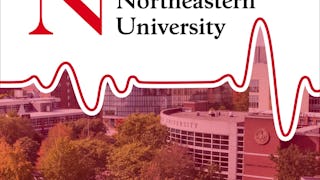This course is best suited for individuals currently in the healthcare sector, as a provider, payer, or administrator. Individuals pursuing a career change to the healthcare sector may also be interested in this course.

Profitez d'une croissance illimitée avec un an de Coursera Plus pour 199 $ (régulièrement 399 $). Économisez maintenant.

Expérience recommandée
Ce que vous apprendrez
Explain how the delivery of healthcare in the U.S. is organized and financed
Compare the American healthcare system to those existing in other countries
Identify emerging trends affecting healthcare delivery, including the American population, technologies, genetic testing, and patient engagement
Compétences que vous acquerrez
- Catégorie : Health Care
- Catégorie : Payment Systems
- Catégorie : Health Systems
- Catégorie : Healthcare Industry Knowledge
- Catégorie : Medical Billing
- Catégorie : Drug Development
- Catégorie : Health Care Administration
- Catégorie : Health Policy
- Catégorie : Medicaid
- Catégorie : Health Disparities
- Catégorie : Tax Laws
- Catégorie : Public Health
- Catégorie : Value-Based Care
- Catégorie : Medicare
- Catégorie : Pharmaceuticals
Détails à connaître

Ajouter à votre profil LinkedIn
Découvrez comment les employés des entreprises prestigieuses maîtrisent des compétences recherchées

Il y a 4 modules dans ce cours
In this module, we will discuss the basic mechanics of paying for volume and how it affects physician payment. Looking ahead, in the U.S., traditional payment approaches for healthcare providers, such as fee-for-service and per diem payments, are being slowly phased out due to concerns about excessive and unnecessary utilization of healthcare services contributing to rising healthcare costs. Additionally, the US healthcare system is undergoing a slow shift from paying providers for volume to paying them for value, which means they are rewarded or penalized based on their quality of care and efficiency.In this module we will explore these traditional payment arrangements as well as the new methods and developments. We will examine the benefits and drawbacks to the different methods and how they affect provider performance.
Inclus
8 vidéos9 lectures5 devoirs2 sujets de discussion
In this module, we will now focus our attention on the diffusion of pricing and prescription medications in the U.S. Prescription drugs account for over 10% of total healthcare spending in the U.S. and are increasingly important for managing chronic conditions. However, the regulatory process for approving new drugs has long been a source of controversy, with stakeholders contending it is inefficient and contributes to rising drug costs. To better understand these issues, we will explore how drugs are developed and regulated.We will also continue on in our exploration of initiatives addressing the cost and value of prescription drugs in this module. Rising drug costs have been a major concern for both the private and public sectors, with initiatives ranging from value-based contracts to federal and state laws aimed at negotiating drug prices and limiting out-of-pocket expenses for patients. While the impact of many of these initiatives is yet to be evaluated, the hope is that they will ultimately result in affordable access to prescription drugs for all Americans.
Inclus
5 vidéos3 lectures5 devoirs1 évaluation par les pairs
Healthcare financing and delivery vary across the globe, with different approaches to public and private sector involvement, as well as universal health coverage. The U.S. has a mixed model with both public and private sector involvement, but lacks universal coverage, while other countries rely predominantly on either the public-or private-sector with varying levels of out-of-pocket spending. In this module, we will explore the key differences between the U.S. healthcare system and the healthcare systems of other countries. We will examine the advantages and disadvantages of various healthcare systems models and evaluate the performances of these systems. How do you feel currently about your quality of care? Perhaps learning about different models of healthcare delivery around the world will give you a new perspective.
Inclus
4 vidéos4 lectures4 devoirs1 sujet de discussion
In this module, we will examine the tax-exempt status of nonprofit hospitals in the U.S., which generate millions in annual revenue but are exempt from paying income, property, and sales taxes. We will also discuss the qualifications that allow these hospitals to enjoy this favorable tax treatment, and the community benefits they are expected to provide in return. Nonprofit hospitals in the U.S. face a unique challenge of providing community benefits while also competing in a highly competitive market for healthcare services. However, research has found that charitable spending can be a source of competitive advantage, leading to increased customer loyalty and financial benefits. We will reflect on the tax exemptions and community benefits as well as the social accountability for healthcare delivery more in this module.
Inclus
8 vidéos6 lectures5 devoirs1 évaluation par les pairs
Instructeur

Offert par
En savoir plus sur Healthcare Management
 Statut : Prévisualisation
Statut : PrévisualisationNortheastern University
 Statut : Essai gratuit
Statut : Essai gratuitStanford University
 Statut : Essai gratuit
Statut : Essai gratuit Statut : Prévisualisation
Statut : PrévisualisationUniversity of Glasgow
Pour quelles raisons les étudiants sur Coursera nous choisissent-ils pour leur carrière ?





Ouvrez de nouvelles portes avec Coursera Plus
Accès illimité à 10,000+ cours de niveau international, projets pratiques et programmes de certification prêts à l'emploi - tous inclus dans votre abonnement.
Faites progresser votre carrière avec un diplôme en ligne
Obtenez un diplôme auprès d’universités de renommée mondiale - 100 % en ligne
Rejoignez plus de 3 400 entreprises mondiales qui ont choisi Coursera pour les affaires
Améliorez les compétences de vos employés pour exceller dans l’économie numérique
Foire Aux Questions
To access the course materials, assignments and to earn a Certificate, you will need to purchase the Certificate experience when you enroll in a course. You can try a Free Trial instead, or apply for Financial Aid. The course may offer 'Full Course, No Certificate' instead. This option lets you see all course materials, submit required assessments, and get a final grade. This also means that you will not be able to purchase a Certificate experience.
When you purchase a Certificate you get access to all course materials, including graded assignments. Upon completing the course, your electronic Certificate will be added to your Accomplishments page - from there, you can print your Certificate or add it to your LinkedIn profile.
Yes. In select learning programs, you can apply for financial aid or a scholarship if you can’t afford the enrollment fee. If fin aid or scholarship is available for your learning program selection, you’ll find a link to apply on the description page.
Plus de questions
Aide financière disponible,
¹ Certains travaux de ce cours sont notés par l'IA. Pour ces travaux, vos Données internes seront utilisées conformément à Notification de confidentialité de Coursera.

